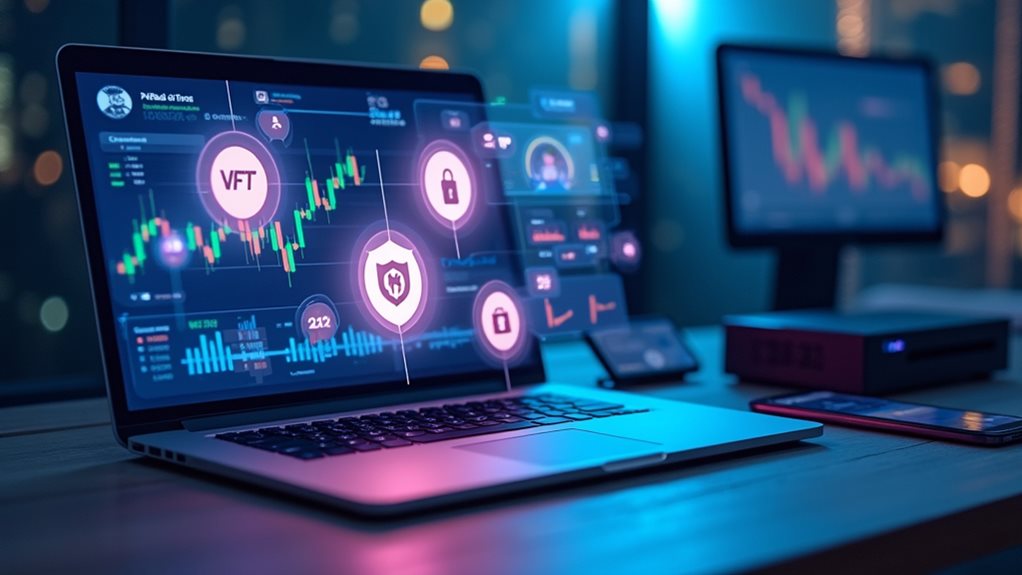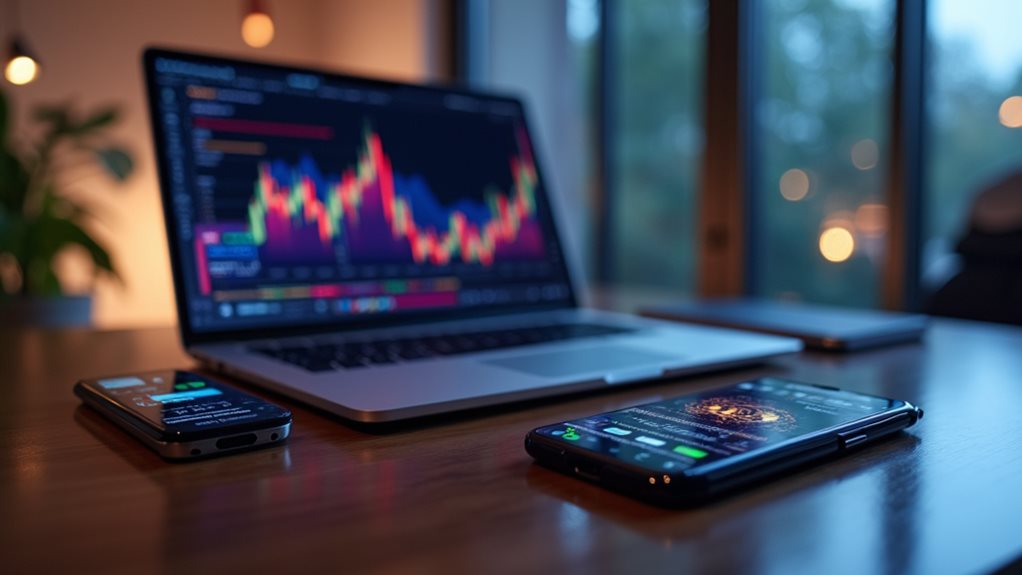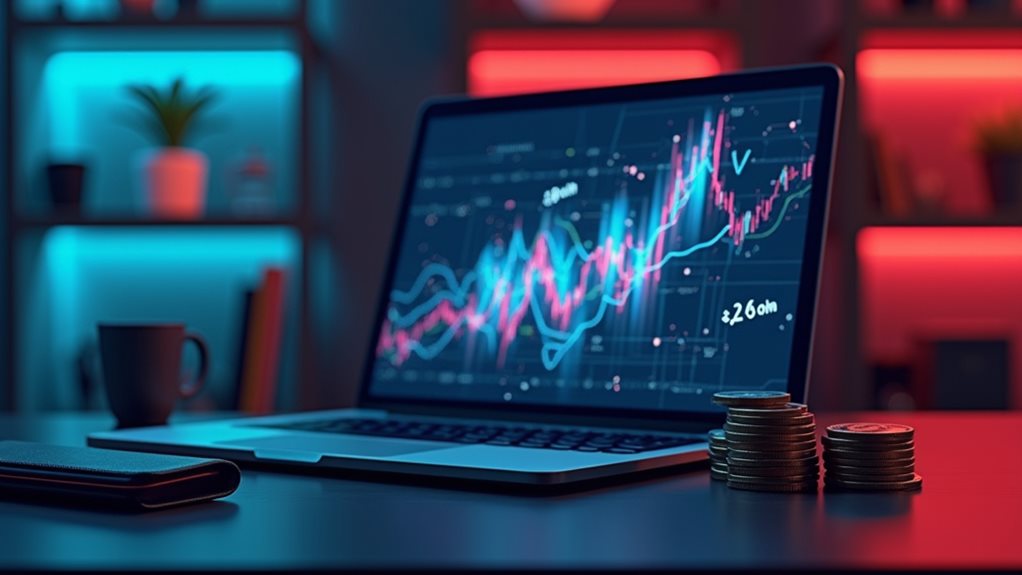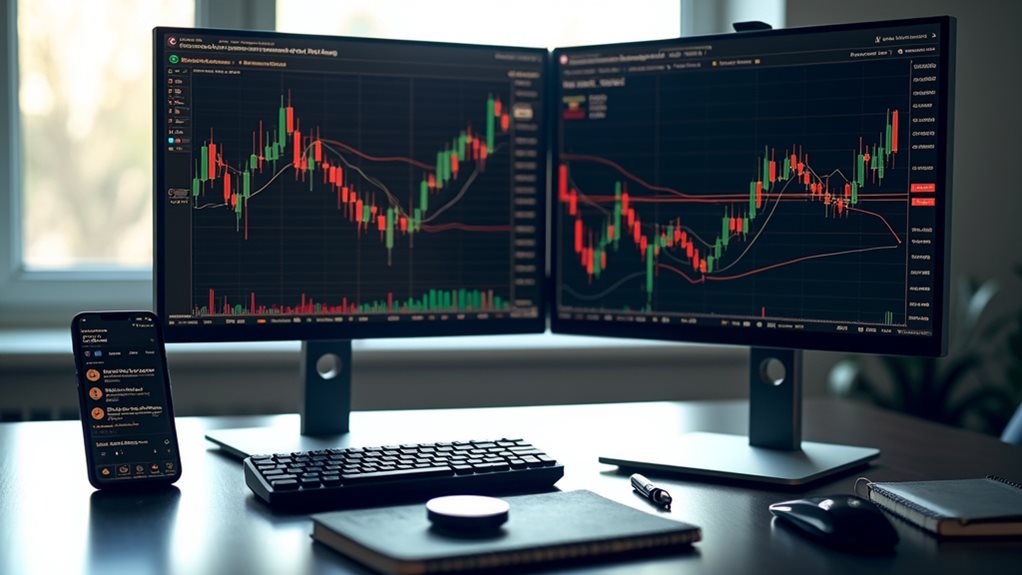NFTs and cryptocurrencies are fundamentally different beasts. Crypto is fungible money; NFTs are unique digital collectibles. Before diving in, set up a secure wallet and enable two-factor authentication everywhere. Stick with established platforms that prioritize security and reasonable fees. Start small with Bitcoin or Ethereum before exploring NFT waters. Transaction fees can blindside you – Ethereum gas prices sometimes hit $150 during congestion, while Solana costs pennies. The market’s shifting from speculation to utility-focused investments.
Understanding the Fundamental Differences Between NFTs and Cryptocurrencies

When diving into the world of blockchain investments, you’ll immediately notice a crucial distinction: NFTs and cryptocurrencies aren’t the same thing.
Cryptocurrencies like Bitcoin are fungible—one Bitcoin equals another. Completely interchangeable.
NFT uniqueness, however, is their defining feature. Each token has a distinct identification code. No duplicates.
Your crypto functions as digital money. You can split it into tiny fractions.
NFTs? They’re like digital collectibles—unique artwork or virtual real estate that can’t be divided.
Ownership verification works differently too. With NFTs, you’re buying exclusive rights to a specific digital item, tracked on the blockchain. Both are managed in a decentralized manner by computer networks worldwide.
Market volatility affects both, but differently. Crypto prices swing based on global adoption, while NFTs fluctuate with collector whims and artist popularity.
Trendy today, worthless tomorrow!
While cryptocurrencies represent a form of digital currency for transactions, NFTs are specifically designed to represent ownership of assets such as digital art or collectibles.
Selecting the Right Exchange Platforms for Your Investment Goals

How exactly do you steer through the dizzying world of crypto exchange platforms? It’s simpler than you think.
Look at security features first – cold storage and multi-factor authentication aren’t fancy extras, they’re fundamental.
Security isn’t a luxury in crypto – it’s your financial armor. Cold storage and multi-factor authentication are non-negotiable basics.
The exchange features that matter most: regulatory compliance (yes, boring but vital) and fee structures that won’t silently drain your investments.
Asset variety matters too. Binance offers deep liquidity but regulatory headaches, while Coinbase is beginner-friendly with higher fees.
Kraken? Security-obsessed with 350+ cryptos.
Payment methods vary wildly – bank transfers are slow but cheap, credit cards are instant but pricey.
Trust matters. Some exchanges have been hacked. Others fined billions.
Choose platforms matching your risk tolerance. No one-size-fits-all here.
Many platforms offer mobile trading through award-winning apps for continuous access to your investments on the go.
For newcomers exploring altcoins, consider KuCoin with its vast selection of over 9,000 cryptocurrencies available on a single platform.
Binance.US users can get trading fee discounts of 25% by using BNB coin for payments.
The Step-by-Step Process of Acquiring Your First Digital Assets

So you’ve chosen an exchange platform—congratulations, that was the easy part.
Now comes the real work: getting your digital assets.
First, set up a wallet. Hardware for serious security, software for convenience. Your choice. Reputable names only: Ledger, MetaMask, Coinbase Wallet. Guard those private keys with your life. Literally.
Fund your account—link a bank account or card. Start small. Nobody became a crypto millionaire overnight. Well, some did. They’re exceptions, not the rule.
For beginners, stick with Bitcoin or Ethereum. Asset diversification comes later. Don’t chase obscure tokens because some TikToker promised “moon shots.” For a more regulated approach, consider spot Bitcoin ETFs that track direct cryptocurrency prices.
Execute purchases on centralized exchanges if you’re new. Verify fees before clicking “buy.” Remember that cryptocurrency transactions are immutable once recorded, making them permanent on the blockchain.
Consider implementing a dollar cost averaging strategy by setting up recurring buys to mitigate the impact of market volatility.
Then transfer to your personal wallet.
Simple process. Difficult discipline.
Essential Security Practices to Protect Your Digital Investments

The crypto world isn’t a forgiving place for the careless. One mistake and poof—your digital fortune vanishes.
Secure wallet usage starts with hardware options like Ledger or Trezor. They keep your keys offline. Smart.
Enable two-factor authentication everywhere. No exceptions.
Keep all software updated. Those patches? They’re far more than annoying pop-ups—they’re your defense system.
Never, ever store your credentials online. Seriously. Write seed phrases on metal cards, not sticky notes or cloud storage. That’s amateur hour.
Safe network practices mean no public WiFi for transactions. Period. Use a VPN.
Monitor your accounts like a hawk.
Consider using multiple wallets to spread risk and better separate trading funds from long-term holdings.
Learn to spot phishing attempts. They’re getting clever these days.
Research thoroughly before investing in NFT projects to avoid falling victim to rug pull scams where developers disappear with your funds.
And before interacting with any smart contract, verify its security. Twice. For NFT contracts specifically, seek out projects using audited libraries from trusted sources like OpenZeppelin rather than custom implementations.
Practical Investment Strategies for Different Risk Tolerances

Whether you’re a cautious newbie or a thrill-seeking crypto enthusiast, your risk tolerance dictates everything in this wild digital frontier. Honest risk assessment isn’t just smart—it’s survival.
Conservative types? Stick to Bitcoin or Ethereum. Use dollar-cost averaging. Maybe try NFT ETFs—less exciting but way safer. Baby steps, people.
Moderates can mix blue-chip cryptos with established NFT projects. Do your homework. Flip occasionally, hold mostly. Balance is key. Two-factor authentication adds an essential layer of security for protecting your investments.
Risk junkies? NFT flipping might be your game. Buy low, sell high—fast. Early-stage projects offer first-mover advantage. Some even dabble in leverage. (Good luck with that.)
Investment psychology matters more than you think. Your emotional reaction to a 30% drop reveals your true risk tolerance. No shame in playing it safe. Seriously.
Diversify across assets. Don’t bet the farm on one cartoon ape. Setting up a secure crypto wallet is essential before entering any NFT marketplace. When evaluating potential NFT investments, consider key factors like the creator’s reputation, utility benefits, and market liquidity to make more informed decisions.
Navigating Transaction Fees and Hidden Costs in Digital Asset Markets

Ever wondered why your digital assets seem to shrink after every transaction? Welcome to the invisible money pit of crypto fees.
Network congestion can send Ethereum gas prices soaring above $150 during peak DeFi frenzies—yep, that’s not a typo. Smart traders use fee estimation tools to avoid these highway robberies. Blockchain design limitations, such as Bitcoin’s 1MB blocks, contribute significantly to high transaction fees during periods of network saturation. With market liquidity drying, transaction costs have become an even bigger concern for traders in 2025.
Network gridlock turns $5 Ethereum trades into $150 nightmares—savvy crypto users dodge these digital tollbooths with fee tracking tools.
- Timing matters: Transaction timing can save you hundreds in fees—trade during off-peak hours when networks are sleepy.
- Platform hopping pays: Cost comparison between exchanges reveals shocking differences (Solana’s $0.00025 vs. Ethereum’s $2.45 average).
- Hidden charges lurk everywhere: Fiat-to-crypto conversions cost more than crypto-to-crypto trades.
Exchange fees vary wildly between platforms. Coinbase might charge 0.40% while DEXs sit at 0.1-0.5% plus gas. Some crypto users prefer zero-fee platforms like Strike and River, which offer fee-free trading but are limited to Bitcoin only.
Trading strategies? Consider layer 2 solutions like Arbitrum to slash costs.
Evaluating Long-Term Value Potential in NFT Collections and Tokens

Hunting for NFTs with staying power feels like searching for diamonds in a digital landfill. The reality? Trading volumes crashed 93% since 2022. Ouch.
Your value assessment should focus on utility, not hype. The market’s evolving—away from get-rich-quick schemes toward actual usefulness.
Gaming economies, real-world asset tokenization, supply chain applications. Stuff that matters.
Collections incorporating AI or serving practical purposes will outlast the purely decorative ones. No surprise there.
The serious money’s betting on utility evaluation over flashy artwork.
The market’s still growing (projected $200 billion by 2030), but it’s maturing fast. Long-term holders are replacing quick-flip speculators. Good riddance.
Remember this: sustainable adoption trumps speculation every time. Always has.
Projects like Bored Ape Yacht Club demonstrate the transition to utility-driven growth as the NFT market matures beyond initial hype cycles.
Intelligent NFTs are transforming the landscape with adaptive assets that change based on user interactions, creating more engaging and valuable digital experiences.
Frequently Asked Questions
How Do NFTS Impact Environmental Sustainability and Carbon Footprints?
NFTs greatly impact environmental sustainability through high energy consumption. You’ll contribute to carbon emissions with each transaction, as minting alone can produce 83kg CO2, comparable to driving hundreds of kilometers in a gas vehicle.
Can I Include NFTS and Crypto in My Retirement Portfolio?
Yes, you can add NFTs and crypto to retirement accounts through self-directed IRAs or crypto ETFs. However, limit them to a small percentage of your investment strategies due to their volatility and regulatory uncertainty.
How Are NFT and Cryptocurrency Gains Taxed in Different Jurisdictions?
Tax regulations vary widely across jurisdictions. You’ll face different capital gains rates, reporting requirements, and asset classification rules. Taxable events differ too, creating compliance challenges that should inform your investment strategies.
What Credentials Should I Look for in Crypto Investment Advisors?
Look for advisors with CDAA, CBDA, or CCE certifications. Verify their regulatory compliance status, advisor experience in traditional markets, and commitment to continuous education. You’ll want someone who understands both crypto technology and investment principles.
How Do Bear Markets Affect NFT Floor Prices Versus Cryptocurrency Values?
During a bear market, NFT floor prices typically fall more dramatically than cryptocurrencies and recover slower. You’ll see collections drop 15-20%, while their liquidity dries up faster than the broader crypto market.








